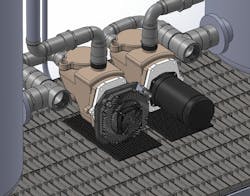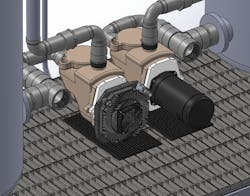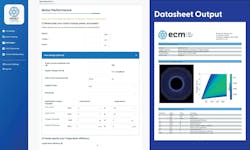Custom Motor Design: SaaS Platform Brings Flexibility to PCB Stator Design
Boston-based ECM PCB Stator Tech is demonstrating the company’s PrintStator Motor CAD design-to-manufacture tool at CES 2024 (taking place Jan. 9-12, 2024 in Las Vegas).
The event will mark the official rollout of ECM’s PrintStator software design-to-manufacture tool, and will demonstrate how the company is setting the pace for designing and optimizing electric motors by combining advanced motor technology and motor CAD.
The main goal is to demonstrate how design engineers, innovators and makers with varying skills levels can design custom motors, incorporating axial flux, PCB Stator technology, according to ECM’s director of communications and investor relations, Jake Bright.
“At CES, we’re releasing the motor kit developed by our engineering team and our chief scientist, Dr. Steven Shaw,” Bright said during a call with Machine Design.
He characterized ECM’s proprietary cloud-based interface, PrintStator SaaS, as a “motor as a software” platform, which allows the user to apply precise performance and dimensional specs to create custom electric motor solutions. The PCB design files can be printed within minutes and are ready for manufacturing.
The Demo: PrintStator Motor CAD Platform
During the call with Machine Design, Bright and three colleagues demonstrated how they could design a custom PCB motor within minutes. For the live demo, Lauren Donald, lead software engineer, ECM, focused on two aspects: the motor catalog and the custom design flow.
READ MORE: R&D Spotlight: PCB Stator Technology Replaces Bulky Copper Windings
After signing in to the PrintStator motor CAD program, the design engineer can plug in constraints for the specific motor they’re looking to design. Donald keyed in basic parameters for a 3hp or 2.2kW motor. The algorithm proceeded to scan for the closest match based on 8,000 designs in the database.
The platform provided the five closest matches to the specifications, including detailed parameters for high efficiency, border radius, diameter, current and voltage estimates.
Ryan Duffy, lead applications engineer, ECM, explained that the engineer can further filter the specifications and constraints to optimize for the desired custom motor design. Common constraints may include increasing or decreasing the voltage, optimal specs for the fan, the target efficiency, the radius and a custom design flow.
The user can also create a custom motor from scratch. In a custom build, the user will populate fields for speed, torque, power and size, said Duffy. Based on these and other custom parameters, the platform will default efficiency to 80% (advanced users may access advanced settings) and will prompt the user to answer queries provided by ECM’s team. This exchange of information is helpful in triggering considerations the user might have overlooked, and extends the platform’s flexibility, explained Duffy.
Invariably, the design engineer may have assumptions and external calculations that can be tested on the platform. During the demo, Duffy compared different magnet grades (such as Neodymium, ceramic, or Samarian cobalt magnets) that are typically used in motors, analyzing the performance differences.
The user can further set the number of motor poles, the PCB layer count or PCB thickness, as well as how thick the magnets should be. In addition, the user can select bearing properties, the shaft and the rotating assembly. “Ideally, you want to keep the bounds large enough to allow the optimizer to find the best solution within that space,” advised Duffy.
Once satisfied with the theoretical configuration, the user will optimize the design with thermal constraints, before generating the design and sending it to the next phase for evaluation and setting it up for manufacturing.
READ MORE: ECM PCB Stator Technology Offers Next-Gen Pump Solution
“I can go to the next design phase and start adding some central manufacturing constraints,” said Duffy. “Depending on the complexity of the design, a design can be ready in five to 25 min., depending on how many constraints are applied and how complex the problem is.”
Motor Design Tool Enables Rapid Production
ECM has to date built prototypes for a range of manufacturing industry partners, ranging from HVAC, consumer electronics, medical, robotics, renewable energy, aerospace, defense, e-mobility and fitness, according to James McMullan, who handles the company’s operations in Europe.
Bright said the PCB Stator innovation and PrintStator Motor CAD platform is a differentiator, as it shifts the design process away from off-the-shelf options. “Anyone, from startup entrepreneur to big company engineer, can use PrintStator for fully customized motor design.”
Bright counts among PCB Stator technology’s advantages the fact that they are smaller, quieter and more energy and space efficient across a broad range of use cases. The PCB Stators achieve “efficiencies in the mid-90s and require just 20% of the raw materials,” noted the company’s website.
Machine Design reported last year on how ECM’s PCB stators replace the bulky copper windings of conventional motors with a thin disc design. The PrintStator designed motors incorporating ECM PCB Stators are smaller, 70% lighter, require less materials and can reach efficiencies in excess of 90%.
READ MORE: Moving Motors Stretch the Possibilities of Long-Travel Motion
ECM is a 2024 CES Innovation Awards Honoree and winner of four International SaaS Awards—including SaaS Solution of the Year; Best SaaS Product for CSR, Sustainability and ESG; and Best SaaS Product for Engineering Management, PLM or CAD.
ECM’s PrintStator software is also a Machine Design IDEA Awards winner.
About the Author
Rehana Begg
Editor-in-Chief, Machine Design
Rehana Begg is the head of content at Machine Design, where she translates complex engineering and manufacturing innovations into practical insights for design and multidisciplinary engineers. With more than 25 years of editorial experience and over a decade working across industrial manufacturing, Begg has covered automation, IIoT, robotics, mechanical design, additive manufacturing, plant operations, reliability and continuous improvement. Her reporting has taken her from corporate boardrooms to plant floors and underground mining stopes, giving her a frontline perspective on engineering challenges. She holds an MBA, a Master of Journalism, and a BA (Hons.) in Political Science. She is committed to lifelong learning and stays connected to the engineering community through ongoing technical engagement.
Email: [email protected]
LinkedIn: @rehanabegg and @MachineDesign
X: https://x.com/MachineDesign
Facebook: Machine Design
YouTube: @MachineDesign-EBM




